By TOM HELMKAMP
The Fort Wayne (IN) Fire Department is a mid-size department that has a very established and solid dive team with a modest budget. We run three separate 24-hour shifts with eight to 12 divers per shift and train every Sunday. We need to be well-versed in all of our skills-especially mask skills-because we typically dive in zero visibility water with all kinds of debris and, sometimes, overhead ice.
During Indiana’s bitter winters, open water diving is not always easy (except during our annual ice dives on non-subzero days). For most of the winter, training outdoors is counterproductive; regulators and equipment freeze up, rigs are parked outside for hours, and harsh conditions tax the divers. Most ice incidents typically happen in early or late winter when the temperature fluctuates and the ice gets weak, so we try to practice under the ice in those conditions. The time between those opportunities is when we complete multiple training sessions in an indoor pool at a local youth facility. We are fortunate to be allowed to train here free of charge. However, this also means we are limited in what skills and props we can use, especially since we need to be vigilant when maintaining the current condition of the facility.
Following are a few drills that repeatedly hit the basics. Some I devised, some were adapted years ago from a Lifeguard Systems training program our dive team completed, and some were passed down to me. I use them annually with my shift members to keep their skill levels up. These drills help prepare them for diving under the ice as well as keep them proficient and ready to go year-round. These drills are simple and can be done with equipment you have on hand and with cheap, easy-to-acquire props.
Perform all of these skills under the constant observation of at least one safety diver who also has a spare air source on hand such as a pony bottle or contingency bottle.
FLASH CARDS
This is a basic drill to start off the pool season. On standard 8 × 10 white paper, I printed the following words: Knife, Shears, Dry Suit Inflator Hose, Weight Belt, Spare Mask, and Pony Bottle & Emergency Ascent (photo 1). I then laminated the cards at an office supply store.
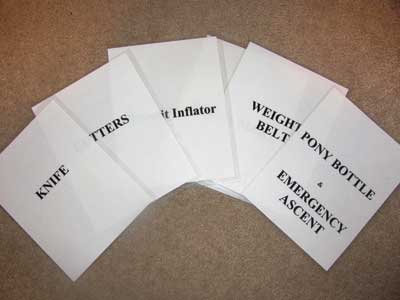 |
| (1) Photos by author. |
The goal here is for the diver to perform the command shown on each card in a quick and proficient manner, which includes removing his knife and shears, disconnecting and reconnecting his dry suit inflator, removing and putting his weight belt back on, changing over to emergency air, switching to a pony bottle regulator and donning a standard scuba mask, and then going back to a full face mask. The “Pony Bottle & Emergency Ascent” card is always last, and the diver goes through the proper procedures for ascending in an emergency out-of-air situation.
BODY BAG
We have completed this drill in the past with a body bag donated from the coroner’s office, but we recently began using a designated diver-friendly bag made by Dive Rescue International. We start by placing a manikin at the bottom of the pool. Two divers, who are given the chance to inspect and familiarize themselves with the bag they will use on the pool deck, enter the water with their masks blacked out. The divers place the victim/manikin inside the bag, secure the bag, and ascend to the surface with it. This can be done twice-once while using communications and blacked-out masks and once without communication and with hand signals. We drop the manikin into the pool again, and each diver completes the drill solo.
This is a great drill to work on with blacked-out communications and with a partner or in a situation when the communication system fails. This drill can frustrate the divers, forcing them to calm down and work together, concentrating on the job at hand.
BLACKED-OUT, OUT-OF-AIR CONTINGENCY
You can perform this evolution while on communications (preferably) or with rope and hand signals. To begin, black out the primary diver’s mask and have him on a rope performing a standard search pattern at the deep end of pool. A backup diver, also wearing a blacked-out mask and carrying a contingency bottle, waits in the shallow end of the pool near the rope tenders that simulate the shoreline. Before the primary diver starts his pattern, we tie a cord, a rope, or a fishing line around his arm or leg, simulating an entanglement that needs to be cut. The backup diver does not see where this is placed.
Midway through the search pattern, the primary diver signals that he is low on air and entangled and needs immediate assistance. The backup diver submerges and follows the rope line down to assist him. The divers make contact; the backup diver passes off the contingency bottle to the primary diver, who advises what is wrong through hand signals or the communication system. The primary diver switches to his pony bottle while the backup removes the entanglement.
Some might ask why the backup diver brings the extra contingency bottle when both divers have pony bottles. We decided that this would be a good way of psychologically calming the divers, letting them know that they have plenty of air on hand and not to panic. The backup diver securely grabs the primary diver’s buoyancy control device (BCD), removes the primary diver’s weight belt, and slowly inflates the backup diver’s BCD so both divers can ascend to the surface.
NUTS AND BOLTS
This drill involves multiple reps of change-outs between the full face mask and the alternate air source without a SCUBA mask. Make sure divers are wearing their gloves.
The diver begins breathing on a pony bottle regulator in full gear with no SCUBA mask. The diver then holds on to the side of the pool and breathes with his face in the water while kicking for two minutes. Next, the diver puts on a full face mask and descends to the bottom of the pool, where four stations are set up.
The first station is a standard plastic milk crate with multiple cords or fishing lines tied across the width of the crate (photo 2). The diver removes his full face mask and switches over to his pony regulator only and locates his knife and shears to cut two ropes free-one with each tool-with the limited visibility of no mask. The diver then replaces the full face mask and proceeds to the next station.
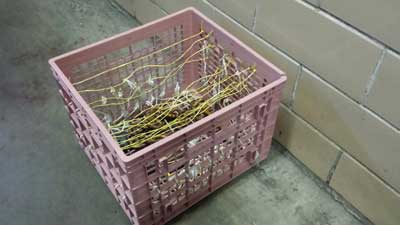
At the second station is a coffee can full of five to six sets of different-size nuts and bolts (photo 3). The diver removes his full face mask again and breathes on the pony regulator. He empties the can and, with limited visibility, finds the proper size nuts and screws them back onto their proper bolts. Once all the bolts are put back together and in the can, the diver puts his mask back on and proceeds to the third station.
 |
| Click to view video |
At the third station are a standard small boat anchor, a carabiner, and a rope. The diver once again removes his full face mask, goes on the pony regulator only, and ties a “figure 8” on a bight, attaching the carabiner to the rope, and then hooks the carabiner to the anchor. He puts the full face mask back on and goes to the final station.
The fourth and final station involves either a tow chain or a tow strap that is maneuvered around a solid object and connected at the ends with whatever is available for the type of strap or chain. This is also done with a change-out to the pony regulator only. On completion, the diver puts on the full face mask and ascends to the surface.
Each year, we have a swim day where all members are required to complete the International Association of Dive Rescue Specialists watermanship test. We designate another day for testing divers’ abilities to be dressed and in the water in less than five minutes as well as checking divers on their ability to obtain neutral buoyancy underwater, to successfully change out their mask to a backup air source, and to remove and replace their BCD underwater (photos 4-6).
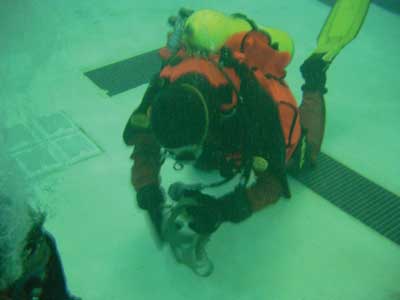
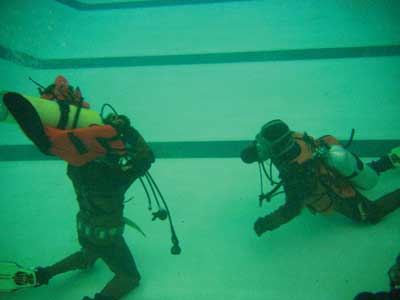
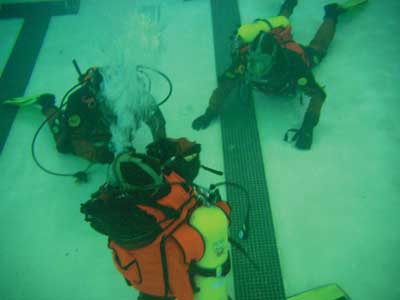
Some might ask why we are concentrating on removing our full face mask when we usually dive in polluted and contaminated water and this is discouraged. Although switching to an alternate air source or removing your face mask is a rare occurrence, we have to be comfortable in our gear and ready to react when the mask is torn from our face, we run out of air, or we get entangled. Constant repetition and constant exposure to breathing underwater with only our nose and face exposed increase the chance that we will react calmly and correctly when an emergency happens. We must build that muscle memory in our brains by using various stressors to make us comfortable.
All of these evolutions are basic skills. But, with the limited equipment, time, and funds available to mid-size and small fire department dive teams, the drills offer easy ways to maintain our divers’ proficiency and mask confidence.
Remember to always have a safety diver under the water within arm’s reach of those performing the evolutions. We always have one diver observing all the evolutions who has an alternate air source ready to go to work if needed. Also, we are fortunate that the facility where we drill always has a trained lifeguard standing by on the pool deck while we use the pool.
If an indoor pool is unavailable, ask local aquatic clubs or community pools if they would be willing to open their doors to your team. Hopefully, you can incorporate some of these ideas into your program and they will spark your own ideas to help keep your divers on their A game.
TOM HELMKAMP is a 15-year veteran and a captain with the Fort Wayne (IN) Fire Department (FWFD) assigned to Fire Station #9. He is also a dive team member/shift leader for the FWFD water rescue team.
Fire Engineering Archives

